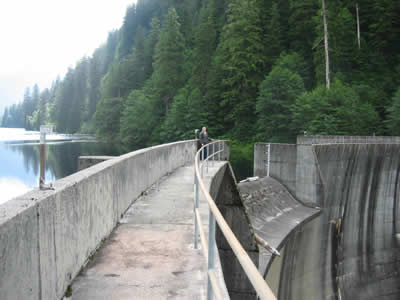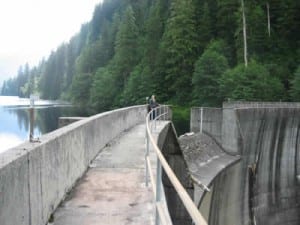Elected officials in three Southeast Alaska towns this fall are taking a closer look at a proposal to streamline the organizations that provide cheap hydro-electric power to Ketchikan, Wrangell and Petersburg. The plan could mean staffing reductions at the two remote power plants to help with rising cost of repair work on generators and electrical lines.
For iFriendly audio, click here:
The Southeast Alaska Power Agency owns the hydro electric power plants at Swan Lake near Ketchikan and Tyee Lake near Wrangell. The agency has agreements with the Thomas Bay Power Authority to operate Tyee and with Ketchikan Public Utilities for the operation of Swan. SEAPA commissioned a review of its organization and those operating agreements and found potential for cost savings.
The agency’s CEO Trey Acteson told the Petersburg city council this month that one of the recommendations from that review is to switch to a single contractor to operate both plants. “And at the end of the day the big goal there is to make some changes to help to minimize the impact of the pressure on the rates,” Acteson said. “Cause the projects are starting to age and we’re doing a lot of what we call R and R projects, which is basically repair, restore, replace the various aging infrastructure so that compounds the challenges with rates as well down the road.”
Acteson said any reorganization would not affect the long-term power sales agreement in place for the three communities. That contract gives Wrangell and Petersburg the first right to the electricity at Tyee Lake and Ketchikan the right to power produced at Swan Lake. With a few exceptions, the contract also requires the communities to buy electricity first from the two SEAPA plants before relying on other sources of power.
The report commissioned by the agency also recommend another possibility, having SEAPA operate the two plants instead of a contractor. Petersburg city councilor Don Koenigs wanted the agency to look more into that possibility. “What are the pros and cons if SEAPA were to take it over themselves and be the power agency and control all that,” Koenigs suggested. “Everything would be internal. We still as communities are protected by the long term contract and we would benefit from that. So, for the council to make a decision as to whether we wanted to disband or to no longer participate in having the two communities of Wrangell and Petersburg providing oversight on Tyee and Ketchikan doing likewise on the other end. Just abolish all that, there would be tremendous savings longhaul. We still have our representation at the SEAPA board level.” Koenigs noted that with SEAPA owning and operating the plants it would be easier for the agency to develop new power sources.
Changes to the operating agreements will take at least two years and may mean a request for proposals, or RFP, seeking a single contractor. SEAPA’s Acteson said the first step would be notifying the two operators that SEAPA was considering the change. “Make the notification, get everybody on board. The next process is to start developing the key components that are kind of the building block for the new organization. Many of those would be included with a single operator, regardless if it’s SEAPA, or could be Thomas Bay authority, could be KPU. It could be any entity if we put it out to RFP. Certainly those two entities would have an advantage because they’re familiar with the projects in some ways,” Acteson said.
Petersburg elected officials plan to teleconference with their counterparts in Wrangell on the issue during a work session November 5th. The SEAPA board may decide on taking the first step for re-organization at a meeting in December.











